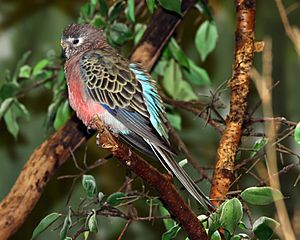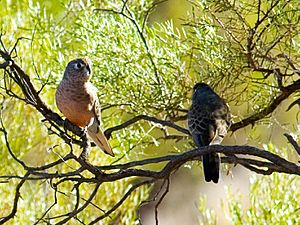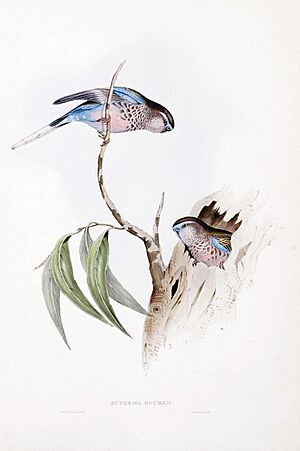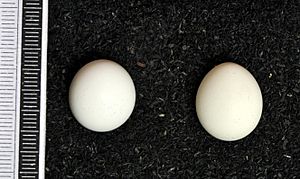Bourke's parrot facts for kids
Quick facts for kids Bourke's parrot |
|
|---|---|
 |
|
| Conservation status | |
| Scientific classification | |
| Genus: |
Neopsephotus
|
| Species: |
bourkii
|
| Synonyms | |
|
Neophema bourkii |
|
The Bourke's parrot (Neopsephotus bourkii) is a small, colorful bird found in Australia. It's also known by other names like the blue-vented parrot or pink-bellied parrot. This parrot is about 19 centimeters (7.5 inches) long and weighs around 45 grams (1.6 ounces). It's the only species in its group, called Neopsephotus. The bird was named after Sir Richard Bourke, who was the Governor of New South Wales from 1831 to 1837.
Contents
What Does the Bourke's Parrot Look Like?
The Bourke's parrot is a small bird, usually between 18 and 23 centimeters (7 to 9 inches) long. Females are often a bit smaller than males. Males weigh about 47 to 49 grams, while females weigh 41 to 49 grams. Both male and female chicks look very similar until they are about nine months old. After that, their full adult colors appear.
In the wild, Bourke's parrots are mostly brown. They have a pink belly, a pinkish chest, and a blue area near their tail. Their legs are dark brown, and their bill is yellowish-brown. Adult male parrots have a blue forehead, but females have very little or no blue there. The colors of their feathers help them blend in with the reddish soil in their dry homes.
People who keep Bourke's parrots as pets have found four different color changes, or mutations. These include yellow, Isabel, fallow, and pink (also called rosa) colors.
The sounds these birds make are often described as a "soft twitter." They can also make "chu-vee" or "chirrup chirrup" sounds. If they feel scared, they might make a "kik-kik-kik" sound.
How Did the Bourke's Parrot Get Its Name?
The Bourke's parrot was first seen by Sir Thomas L. Mitchell in New South Wales in 1835. He decided to name the bird after Sir Richard Bourke, who was the governor of the state at that time.
In 1841, a bird expert named John Gould wrote the first scientific description of the Bourke's parrot. He first put it in a group called Euphema bourkii. Later, it was moved to the Neophema group, which includes other grass parakeets.
In the mid-1990s, scientists decided the Bourke's parrot was special enough to have its own group, called Neopsephotus. This was because there wasn't much proof that it could breed with other Neophema parrots. Also, Bourke's parrots look different and travel around a lot in the dry parts of Australia. Even though it's in its own group now, people still often call it a type of grass parakeet.
Where Do Bourke's Parrots Live?
Bourke's parrots are native to Australia. They are known to travel a lot, following where they can find water and food. This means they live across a very large area. While they mostly live in places where not many people live, they have also been seen in towns and cities.
You can find these parrots from the southwestern parts of Queensland all the way into western New South Wales. They also live throughout Central Australia, in the far northern parts of South Australia, and in some parts of Western Australia. Their favorite places to live are dry plains with lots of Acacia trees, especially the mulga tree. They also live in native cypress and other open eucalypt woodlands.
How Do Bourke's Parrots Behave?
Bourke's parrots spend time both in trees and on the ground. They perch and build nests in trees, but they also spend a lot of time on the ground. Their brown feathers help them hide easily there. When they fly, they make short, fast flights, often gliding. They usually fly close to the ground in quick bursts as they move between trees. Their wings beat very little, making a soft whirring sound.
In the wild, Bourke's parrots usually live in pairs or small groups of about four to six birds. Sometimes, especially when there's a drought, they can form much larger groups with hundreds of birds.
Breeding and Raising Young
During the time they are nesting, male Bourke's parrots protect their territory very strongly. They will chase away any other birds that come too close. The breeding season for Bourke's parrots usually happens between August and October. However, if there's plenty of food and water, it can last until December.
Bourke's parrots are monogamous, meaning they stay with one partner. Their nests are usually found about 1 to 3 meters (3 to 10 feet) off the ground. They build them inside hollow branches of mulga trees or other acacia trees. The female lays her eggs on a soft bed of decayed wood at the bottom of the hollow. A female Bourke's parrot usually lays 3 to 6 eggs. She sits on them for 18 to 19 days to keep them warm. During this time, the male parrot brings her food. She only leaves the nest to find water or to go to the bathroom.
Once the chicks hatch, both parents work together to feed them. The young birds start to fly (fledge) when they are about 4 weeks old. They become fully independent and can take care of themselves about 8 to 10 days after they start flying.
What Do Bourke's Parrots Eat?
Bourke's parrots look for food on the ground and in bushes. They mostly eat grasses and seeds. They are most active when looking for food at dusk (evening) and dawn (morning). Because they eat seeds and then move around, Bourke's parrots help spread seeds to new places.
Bourke's Parrots as Pets
The Bourke's parrot is a fairly popular pet bird. Many new bird owners like them because they are known for being quiet and calm. Since they are so peaceful, Bourke's parrots can often be kept with other small birds like finches, doves, and other small parakeets.
There have been a few times when Bourke's parrots have bred with scarlet-chested parrots (Neophema splendida), creating hybrid birds.
Are Bourke's Parrots in Danger?
The IUCN says that the Bourke's parrot is not a threatened species. This means their numbers are healthy. The biggest dangers to these birds are predators like red foxes and feral cats, which were brought to Australia from other places. Long periods of dry weather (drought) and the clearing of watering holes can also harm their populations.
However, scientists haven't seen a big drop in their numbers. In fact, their population seems to be slowly growing. This is probably because they live in such a wide area and don't come into contact with predators as much as some other parrot species.
See also
 In Spanish: Periquito rosado para niños
In Spanish: Periquito rosado para niños





